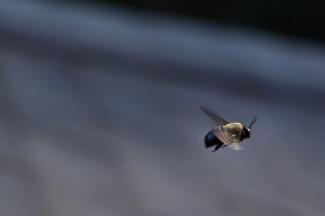
Image Credit: Jessica Lucia
Printable Guides
Oregon Department of Agriculture Guide to Bee Pollinators PDF
Streamlined Bee Monitoring Protocol For Assessing Pollinator Habitat PDF
Species Richness of Bee Guilds
Species richness of bee guilds and reference to known specialist-feeders within each group.
(*= probably in PNW, but not yet confirmed; ?= prefers that genus, but may or may not be an actual specialist).
There is a vast need for more and better information.
|
BEE GROUPS |
taxa Pac Coast |
taxa Oregon |
specialized hosts in Oregon |
|
Spring Bees |
268 |
152 |
MANY!! (see below) |
|
Yellow-banded panurgine Bees |
666 |
41 |
MANY!! (see below) |
|
Shiny black panurgine Bees |
18 |
4 |
Potentilla, Ceanothus |
|
Silk-lining Bees |
52 |
13 |
MANY!! (see below) |
|
Pollen-regurgitating Bees |
30 |
18 |
Potentilla (2). |
|
Oil-collecting Bees |
2 |
1 |
general Compositae (2), Eschscholzia (1*), Steironema (1 +!*). |
|
Hesperapis, Melitta |
25 |
1 |
Eschscholzia, Helianthus |
|
Banded green Sweat-Bees |
7 |
5 |
none |
|
Socially-variable Sweat-bees |
ca150 |
ca75 |
none |
|
Turret-making green Sweat-bees |
3 |
2 |
none |
|
Alfalfa-bee & relatives |
4 |
2 |
Medicago (1 emphasis). |
|
Nomia |
4 |
1 |
Helianthus (1*). |
|
Low-antennae Dufour’s Bees |
87 |
15 |
MANY!! (see below) |
|
Iridescent mason Bees |
100 |
67 |
Cirsium (1), general Compositae (8), general legumes (12 +7?), Penstemon (1), Ribes (1?). |
|
Pre-existing cavity-nesting Bees |
149 |
43 |
Phacelia, Cryptantha, Penstemon, ++++ |
|
Hornet-mimic Bees |
48 |
26 |
general Compositae (6 +1?), general legumes (3?), Phacelia (2 + 2?) |
|
Leaf-cutting Bees |
87 |
37 |
Clarkia (2), general Compositae (12), general legumes (3), Oenothera (4). |
|
Digger (Burrowing) Bees |
57 |
17 |
Arctostaphylos (2?) |
|
Long-horned Bees |
103 |
49 |
MANY!! (see below) |
|
Turret-building fuzzy Bees |
44 |
8 |
Helianthus (1*), Sidalcea 1 +1*), Sphaeralcea (1). |
|
Giant Carpenter-bees |
6 |
2 |
none |
|
Micro Carpenter-bees |
12 |
8 |
Clarkia (1) |
|
Honeybee |
1 |
1 |
none |
|
Bumblebees |
38 |
28 |
Delphinium (1?) |
|
Digger Cuckoo-bees |
13 |
7 |
none |
|
Classic Cuckoo-bees |
ca125 |
ca 44 |
none |
|
Large Cuckoo-bees |
ca75 |
ca35 |
none |
|
Hornet Cuckoo-bees |
5 |
2 |
none |
|
Leaf-cutter Cuckoo-bees |
28 |
18 |
none |
|
Halictine Cuckoo-bees |
ca40 |
ca15 |
none |
|
TOTALS |
2300 |
850 |
perhaps about 250 specialists |
Spring Bee specialist hosts: Agoseris (2), Arctostaphylos (2*), Berberis (1?), Camissonia (2), Ceanothus (4 +1*),Chrysothamnus (+Gutierrezia) (2), Cichorieae (2), Clarkia(2), Compositae in general (3), Cornus (3), Cryptantha (2*), Ericaceae (3), fall Compositae (7), Fragaria+ (2), fruit trees (2), Helianthus (2), Lasthenia (+ Layia) (2 +1*, legumes (1), Limnanthuis (1*), Linanthus (3*), Lomatium (2), Mentzelia (1*), Nemophila (1 +1*), Platystemon (1*), Potentilla (2), Ranunculus (3), Rhus (1), Ribes (1 +2?), Salix (12 +3*), Stanleya (1*?), Trifolium (1), Zigadenis (+Tofieldia) (1).
Low-antenna Dufour’s Bees: Calochortus (2), Campanula (2), Eschscholzia (1*), Gayophytum (1), Gilia (1 +1*), Mimulus (1), Oenothera (1 +1*), Phacelia (1), Potentilla (1), Symphoricarpos (1), Trifolium (2).
Long-horned Bees: Amsinckia (1?*), Arctostaphylos (1*), Chrysothamnus (+Gutierezzia) (4), Cirsium (1), Clarkia (1), Cucurbita (1), Delphinium (!?), general Compositae (7), general legumes (1 +4?), Grindelia (1), Helianthus (2), fall Compositae (5), Vernonia (1*).
Yellow-banded panurgine Bees: Aster (+Erigeron) (3), Calochortus (1), Chrysothamnus (+Gutierrezia)(9), Cleome (2), Cleomella (1), Eriogonum (1), Eschscholzia (1), fall Compositae (3), general Compositae (1), Malacothrix+ (1*), Mentzelia (1*), Monardella (1*), Perideridia (1), Phacelia (1), Potentilla (1), Salix (3), Trifolium (2 +1*).
Shiny black panurgine Bees: Ceanothus (1), general Compositae (1), Limnanthes (1), Potentilla (1 +1?), Ranunculus (1*).
Pre-existing cavity-nesting Bees: Cryptantha (1 +3*), fall Compositae (1), general Compositae (1 +1?), general legumes (1?), Lotus (2?), Nemophila (*1?), Penstemon (6), Phacelia (7 +1?).
Silk-lining Bees: fall Compositae (6), general Compositae (1), Heuchera (2), Mertensia (1), Peridia (1?), Phacelia (1), Potentilla (1).